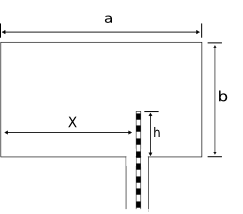The Physics Behind the Cantenna
The Cantenna - A Physics 632 Web Project
The physics of a Cantenna is quite complicated and in practice most people use a simple applet to calculate the dimensions of the can needed. This will be covered in the How to Build section of this website. Here I will work a graduate level physics problem that is similar to our Cantenna problem. If you are not at least a graduate level physics student, there is a good video explaining the general idea on the Links page. If you can follow this, it is a simple matter to move to the Cantenna problem, which is an exercise I will leave to the reader ( you don't learn anything it I just do it for you).
This problem is problem 8.19 in John David Jackson's Classical Electrodynamics, Third edition, which is a really good resource for all things electromagnetic. Chapter 8 covers Waveguides, Resonant Cavities, and Optical Fibers. On with the Problem:
8.19
The figure below shows a cross-sectional view of an infinitely long rectangular waveguide with the center conductor of a coaxial line extending vertically a distance h into its interior at ![]() . The current along the probe oscillates sinusoidally in time with frequency
. The current along the probe oscillates sinusoidally in time with frequency ![]() , and its variation in space can be approximated as
, and its variation in space can be approximated as
![]() . The thickness of the probe can be neglected. The frequency is such that only the
. The thickness of the probe can be neglected. The frequency is such that only the ![]() mode can propagate in the guide.
mode can propagate in the guide.
(a)
Calculate the amplitudes for excitation of both TE and TM modes for all(b)
For the propagating mode show that the power radiated in the positive z direction is

